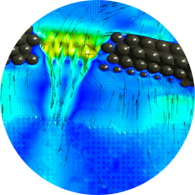Rainfall interception experimentation and modelling for enhanced impact analysis of nature-based solutions
Forests and urban trees are among the key elements of the water cycle and have been recognized as important components in climate change mitigation. They are considered as one of the most effective and sustainable climate adaptation solutions in urban areas and denoted as blue-green or nature-based solutions. Forests perform important buffering functions, such as interception of precipitation and water retention. However, for the successful and efficient use of NBS to mitigate climate change effects, an in-depth knowledge about various influences on the water balance is needed (e.g., how much water from precipitation is intercepted by vegetation and how much water falls through). Information obtained in the scope of the measurements at the experimental catchments or plots is essential for understanding of the rainfall interception process and impact of the interception on the water balance. Despite the crucial importance of rainfall interception measurements for the green infrastructure planning, rainfall interception measurements are rarely conducted, especially in urban environment. Thus, high-frequency rainfall interception and runoff measurements will be conducted at the experimental plot located in the city of Ljubljana, Slovenia. These measurements will be used for the evaluation of the urban hydrology model’s performance and for the upscaling and impact analysis of blue-green solutions.
- Improvement of the understanding of the rainfall interception process in urban environments;
- Evaluation of the urban hydrology model’s performance from the rainfall interception perspective;
- Apply the refined model for upscaling and impact analysis of blue-green solutions at the city district
scale.
Wu X., Moustakas S., Bezak N., Radinja R., Alivio M.R., Mikoš M., Dohnal M., Bares V., Willems P. (2024). Assessing the performance of blue-green solutions through a fine-scale water balance model for an urban area, Science of The Total Environment, Volume 948, 14750, https://doi.org/10.1016/j.scitotenv.2024.174750

